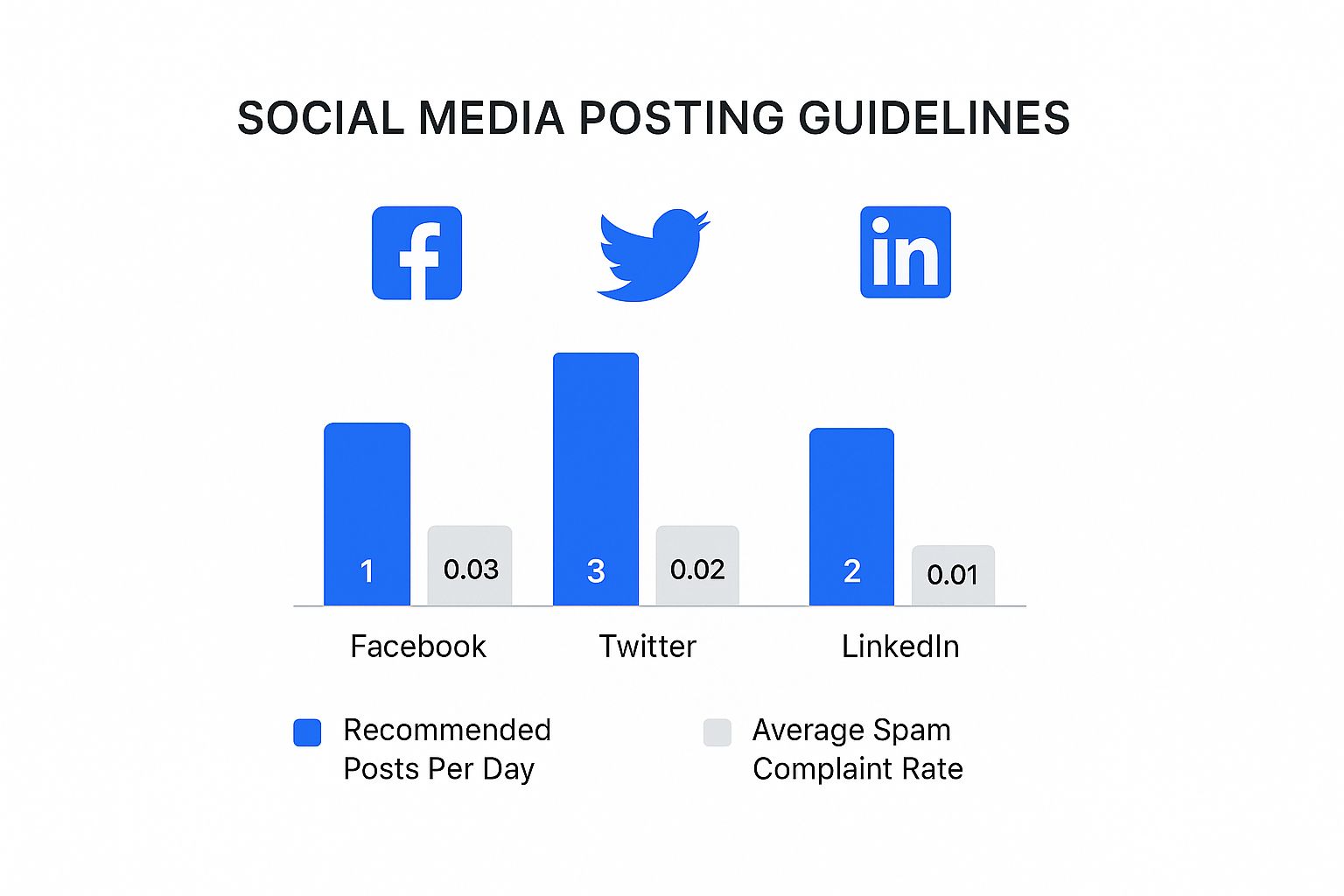Understanding The Real Difference Between Smart Sharing And Spam

Smart sharing and spam might seem similar, but their core difference comes down to intention and adaptation. Smart sharing strategically distributes valuable content to various audiences. It considers each platform's unique culture and tailors the message accordingly. Spam, on the other hand, blasts the same message indiscriminately across multiple channels, ignoring audience needs and preferences.
This often leads to low engagement, damages brand perception, and can even incur penalties from platform administrators. Think of it like clothing: a tailored suit impresses with its perfect fit, while a one-size-fits-all garment feels awkward and looks out of place. For a deeper understanding of crossposting, check out this helpful resource: What is Crossposting?
Why Purposeful Posting Matters
The biggest crossposting mistake isn't posting too much, but posting without a purpose. Each piece of content needs a clear objective. Ask yourself: are you driving website traffic, generating leads, building brand awareness, or fostering community engagement?
Understanding your goals informs your content strategy and helps avoid the spam trap. For example, a promotional post successful on Instagram might not suit the professional networking focus of LinkedIn. Accidentally crossing the line between automation and spam is easy. For advice, see: How To Tread Carefully Between Linkedin Automation And Spamming
The Pitfalls of Robotic Content
Robotic content is a clear sign of spammy crossposting. This content feels impersonal, generic, and obviously copied and pasted across platforms. It lacks authenticity and nuance, ignoring platform-specific best practices like character limits, hashtag usage, and visual formatting.
Cross-posting offers benefits like time-saving and increased reach, but it can also lead to repetitive, spammy content. Posting identical content simultaneously on all platforms reduces engagement and alienates followers. Successful cross-posting involves adapting relevant content to each platform's tone and format, maintaining engagement and authenticity. Learn more about effective cross-posting strategies.
Adapting Your Message For Each Channel
Avoiding spam in crossposting requires tailoring your message to each platform's unique characteristics. Understand the nuances of each platform's audience, culture, and communication style.
Twitter thrives on short, snappy updates, while LinkedIn prefers in-depth, professional content. Instagram prioritizes high-quality visuals, while Facebook offers a more versatile format supporting longer text posts and diverse media. Adapting your content to these differences maximizes engagement and prevents being flagged as spam.
Mastering Platform-Specific Content That Feels Native

The infographic above illustrates recommended posting frequency and average spam complaint rates across Facebook, Twitter, and LinkedIn. LinkedIn, with its lower recommended posting frequency, has a correspondingly lower spam complaint rate. This highlights the importance of understanding platform-specific best practices.
Simply replicating content isn't enough; adapting your message is crucial. This prevents your content from being perceived as spam.
Understanding Platform Nuances
Each social media platform has its own unique "personality." LinkedIn cultivates a professional atmosphere, perfect for sharing industry insights and career updates.
Instagram thrives on high-quality images and Stories due to its visual nature. Twitter’s fast-paced environment favors concise, timely updates.
Facebook fosters community interaction and allows for more diverse content formats. Recognizing these distinctions is the first step towards mastering platform-specific content. Effective cross-posting hinges on understanding these nuances.
Buffer's analysis of over 100,000 social media users revealed that consistent posting leads to five times more engagement. However, simply cross-posting without tailoring content can decrease engagement. This can also lead to your content being marked as spam. Adapting your message to each platform is key to avoiding this. You can find more detailed statistics here.
Adapting Your Message, Not Just Replicating It
Think of it like trying to wear the same outfit to a formal dinner and a casual beach outing–it just wouldn't work. The same principle applies to cross-posting.
To avoid being flagged as spam, your content must feel native to each platform. This means adjusting the format, tone, and style of your message.
- Headlines: A detailed, informative headline works best on LinkedIn. On Twitter, a concise, attention-grabbing headline is more effective.
- Visuals: Instagram demands high-resolution, visually appealing images or videos. A simple image, or even no visual, might be sufficient for Twitter.
- Captions: Craft captions that resonate with each platform's audience. LinkedIn users prefer professional language, while Instagram welcomes a more casual tone.
Crafting Platform-Appropriate Calls to Action
Your calls to action should also align with the platform. On LinkedIn, encourage users to "Learn More" or "Connect." On Instagram, a "Shop Now" or "DM for Details" approach might be better.
This targeted approach helps your content integrate seamlessly into each platform's ecosystem. It fosters genuine engagement instead of triggering spam filters.
Maintaining Brand Voice While Speaking Each Platform’s Language
Maintaining a consistent brand voice across platforms is crucial. Think of it as speaking different languages while retaining your core personality.
This involves understanding each platform's communication style while staying true to your brand’s values. For example, a brand with a humorous voice can adapt its humor to each platform.
A witty tweet could translate to a lighthearted Instagram caption or a slightly more formal, yet still engaging, LinkedIn post. Finding the right balance between adaptation and consistency is key.
This ensures your brand remains recognizable and authentic across all channels. It also fosters trust and builds lasting relationships with your audience. Adapting to each platform shows respect for the community and reduces the risk of being flagged as spam.
To further illustrate this point, let's look at a comparison table:
A comprehensive comparison of content requirements, optimal formats, and best practices for major social media platforms helps content creators understand the specific needs of each platform. This leads to better engagement and reduces the risk of being flagged as spam. The following table offers a guide for adapting your content across different platforms:
Platform-Specific Content Adaptation Guide
| Platform | Optimal Content Length | Best Format | Key Adaptation Strategy | Spam Risk Factor |
|---|---|---|---|---|
| Varies, but shorter posts tend to perform better | Text, images, videos, live streams | Focus on community building and engagement | Moderate | |
| 280 characters or less | Short text, images, GIFs, short videos | Concise and timely updates; use relevant hashtags | Moderate to High | |
| Longer posts are acceptable, but keep it focused | Text, articles, images, videos, professional updates | Professional language, industry insights, career updates | Low | |
| Captions can be lengthy, but visuals are key | High-quality images and videos, Stories, Reels | Visually appealing content, engaging captions, relevant hashtags | Moderate |
By understanding the optimal content length, best formats, and key adaptation strategies for each platform, you can effectively tailor your message and avoid common pitfalls that could lead to your content being perceived as spam. This strategic approach will help you maximize your reach and engagement across various social media channels.
Leveraging Smart Tools For Intelligent Content Distribution

Modern technology offers a range of solutions for distributing content strategically. This is particularly helpful when aiming to avoid the common pitfalls of spamming during crossposting. AI-powered tools can analyze your content's performance and even suggest platform-specific adaptations. This ensures your message resonates effectively with each unique audience.
Automating Your Content Distribution
Automation systems offer the ability to schedule posts intelligently. This includes factoring in platform-specific peak times and understanding audience behavior. Resources like this guide on social media cross-posting offer valuable insights. Such automation tools help maintain a consistent online presence without requiring constant manual intervention, freeing you to focus on content creation. Some advanced tools can even create content variations automatically, all while preserving quality and authenticity.
AI-Powered Content Adaptation
Artificial intelligence (AI) plays a crucial role in spam detection and prevention. Understanding the evolving nature of AI in this realm is essential to avoid spamming when cross-posting. For example, since the release of ChatGPT in 2022, there has been a 135% increase in novel social engineering attacks by early 2023, exploiting user emotions. More detailed statistics on spam can be found here. This highlights the need for AI not only in content distribution but also in protecting against increasingly sophisticated spam tactics.
Personalizing Your Crossposting Strategy
AI and machine learning offer the power to personalize your crossposting strategy, leading to higher engagement rates across all channels. By analyzing audience data, AI can tailor content to specific demographics and interests on each platform. This targeted approach ensures your content feels relevant and engaging, avoiding the generic feel of spam. This personalized approach boosts the effectiveness of your message and strengthens your connection with your audience.
Real-World Examples and Best Practices
Several successful brands demonstrate the power of machine learning in personalizing crossposting strategies. Some brands use AI to analyze user behavior across multiple platforms. This data then informs the content adaptation process. Headlines are tweaked, images are optimized, and calls to action are tailored to the specific platform and audience. This strategic approach maximizes engagement and minimizes the risk of being flagged as spam. Another effective strategy involves using AI to determine the ideal posting frequency for each platform, maintaining consistent visibility without overwhelming the audience. Learning from these real-world examples can help you optimize your own crossposting strategy for maximum impact and minimal spam risk. This data-driven approach ensures that your content reaches the right audience at the right time, on the right platform.
Strategic Timing That Keeps Your Audience Engaged
Timing is everything in the world of cross-posting. The line between a helpful online presence and annoying spam is often defined by when and how often you share your content. This means understanding how your audience overlaps across different platforms, and then creating posting schedules that feel natural, not automated.
Identifying Peak Engagement Windows
Finding the right time to connect with your audience on social media is crucial. Think of it like trying to have a conversation in a crowded room – your message will get lost unless you speak at the right moment. This means understanding when your followers are most active on each platform. Tools like PostOnce can help analyze your content performance across different channels and suggest optimal posting times.
For example, LinkedIn might be most effective during business hours, while Instagram could generate better engagement in the evening. Experimentation and data analysis are key to identifying these peak engagement windows.
Spacing Out Your Crossposts
Posting the same message across multiple platforms simultaneously can feel like spam, even if your content is valuable. Imagine receiving the same flyer in your mailbox multiple times a day—it’s more likely to end up in the trash.
Effective crossposting requires strategic spacing. Instead of overwhelming your followers, consider a staggered approach. Share a link to your blog post on Twitter first, then post a related image on Instagram a few hours later, and follow up with a discussion prompt on LinkedIn the next day. Learn more about effective scheduling. This creates a sense of continuity without being repetitive.
Managing Multiple Time Zones
Scheduling posts becomes even more complex when your audience spans multiple time zones. Prime time in New York City might be the middle of the night in London. Tools like PostOnce can help you schedule posts according to different time zones, ensuring your content reaches the right people at the right time, regardless of their location.
Maintaining a Consistent Presence Without Overposting
Consistency is essential for social media success, but there's a delicate balance between being present and being overly promotional. Finding the optimal posting frequency for each platform is critical. Some platforms, like Twitter, thrive on multiple daily updates, while others, like LinkedIn, favor a more measured approach. Overposting can lead to audience fatigue and decreased engagement, even with high-quality content.
To help illustrate recommended posting frequencies and avoid spam perception, take a look at the table below. It offers guidance on combining platforms effectively:
Cross-Posting Frequency Guidelines
| Platform Combination | Maximum Daily Posts | Minimum Time Gap | Peak Engagement Hours | Risk Level |
|---|---|---|---|---|
| Twitter & Instagram | 5 & 3 | 2 hours | Twitter: 9am-5pm, Instagram: 5pm-9pm | Low |
| LinkedIn & Facebook | 2 & 1 | 4 hours | LinkedIn: Business hours, Facebook: Afternoons/Evenings | Low-Medium |
| Twitter & LinkedIn | 5 & 1 | 6 hours | Varies based on industry and audience | Medium |
| Facebook & Instagram | 1 & 2 | 3 hours | Facebook: Afternoons, Instagram: Evenings | Low |
| Twitter, Instagram, Facebook & LinkedIn | 5, 2, 1 & 1 | 8 hours between any two platforms | Varies greatly | High |
The table above provides a general guideline. Remember to analyze your own audience data and adjust these recommendations accordingly. Finding the right balance is key to maintaining a strong presence without overwhelming your followers.
Overposting can quickly make your content feel like spam, regardless of its value. Remember that quality is more important than quantity. Focus on creating engaging content that offers real value to your audience instead of trying to inundate their feeds with constant updates. This focused approach builds authentic connections and avoids the negative repercussions of overposting.
Building Genuine Connections Across Every Platform

Crossposting is more than just spreading your message; it's about cultivating real connections. True success lies in fostering authentic relationships with your audience across various platforms. This means moving beyond simply broadcasting content and focusing on interactions that resonate.
Engaging in Meaningful Interactions
Think of crossposting as building bridges between your brand and your audience. Likes and shares are the initial introductions, but true connection comes from deeper engagement. This includes responding to comments, asking questions, and participating in discussions.
When you actively engage, you transform passive consumers into active participants.
For example, if you share a blog post about content creation on LinkedIn, ask your network for their top writing tips. On Instagram, post behind-the-scenes content and invite followers to share their experiences. This fosters a sense of community and encourages genuine interaction.
This interaction is crucial for avoiding the perception of spam. You're inviting conversation and building relationships, not just broadcasting. Research shows creators prioritizing engagement see 73% higher follower growth and 2.4x more meaningful interactions. Discover more insights about cross-platform engagement.
Maintaining an Authentic Voice
Authenticity is key when communicating across multiple platforms. Your communication style should adapt to each platform’s environment, just like your attire changes for different occasions.
Your core message and brand values should remain consistent, but adjust your tone and delivery.
This means understanding each platform's culture. The professional tone of LinkedIn might not suit the informal atmosphere of Instagram. However, your authentic voice should always shine through, building trust and strengthening connections.
Creating Content That Sparks Conversation
Your content fuels cross-platform engagement. Instead of repurposing the same message, tailor your content to spark unique conversations on each platform.
This could involve posing thought-provoking questions, sharing behind-the-scenes glimpses, or creating platform-specific polls. By actively seeking input, you demonstrate that you value your audience’s perspectives and encourage deeper engagement. This transforms your crossposting from broadcast to dialogue.
Managing Discussions Effectively
Managing discussions across platforms can be challenging, but it’s essential for building genuine connections. Respond to comments and messages promptly, address questions thoroughly, and foster a positive environment.
It also means handling negative feedback constructively. By actively participating in and moderating conversations, you demonstrate commitment to your audience. This avoids the impression of spamming and builds genuine relationships. This dedication builds trust and strengthens your brand. By actively listening and responding thoughtfully, you transform followers into loyal advocates.
Tracking Success and Avoiding Red Flags
Effective crossposting requires ongoing monitoring and optimization. This means moving beyond superficial metrics like follower count and concentrating on data that offers real insights into your audience's behavior. By tracking the right metrics, you can identify potential spam-related problems before they affect your reach and harm your online presence.
Measuring What Matters: Engagement Quality Over Reach
While reach is important, focusing only on how many people see your content can be deceptive. True success lies in how your audience interacts with that content. Are they commenting, sharing, saving, or clicking through to your website? These actions show genuine interest and demonstrate the value you provide.
For instance, a post with a million views but no comments might suggest your message isn't connecting with your audience. This emphasis on engagement quality is data-backed. Analysis of 25,000 cross-platform content campaigns reveals that creators prioritizing engagement metrics see 156% better long-term audience retention and 89% fewer spam-related penalties. Find more detailed statistics here. This underscores the importance of looking beyond superficial metrics.
Tools for Tracking Audience Sentiment and Engagement
Several tools can assist in monitoring audience sentiment and engagement across various platforms. Some platforms offer built-in analytics dashboards providing insights into post performance. Third-party social media management tools often offer more advanced features, like sentiment analysis, which can assess the overall positive or negative tone of comments and mentions.
These tools offer a valuable summary of how your audience perceives your content and can help identify potential issues early. Building authentic connections across platforms is critical, and this includes understanding the nuances of each social channel. For example, car dealerships can leverage social media strategies for car dealerships.
Identifying Early Warning Signs
Declining engagement rates, negative comments, and a drop in shares can signal that your crossposting strategy requires adjustment. These are critical red flags to watch for. For example, a sudden decrease in comments on your LinkedIn posts after implementing a new crossposting strategy may mean your content isn’t resonating with that audience.
This could stem from several factors, such as posting too often, sharing irrelevant content, or using a tone that doesn't fit the platform's professional environment.
A/B Testing and Course Correction
A/B testing provides a robust method for refining your approach. This involves creating two slightly different versions of your content and sharing them with separate audience segments. By analyzing each version's performance, you can pinpoint what resonates best. This data-driven approach enables informed decisions about your content strategy.
When engagement dips, prompt action is key. This could involve adjusting your posting frequency, revising your content calendar, or re-evaluating your target audience. Adaptability is vital for long-term crossposting success.
Measuring Success Beyond Vanity Metrics
True crossposting success goes beyond superficial metrics like likes and followers. It's about cultivating a loyal community that values your content and engages with your brand. This means tracking metrics that reflect authentic interest and meaningful interactions.
Consider these key indicators of success:
- Conversion rates: How many people take the desired action after encountering your content?
- Referral traffic: How much traffic are your posts directing to your website?
- Community growth: Are you building a sense of community and fostering meaningful interactions?
By focusing on these metrics, you gain a deeper understanding of your crossposting strategy’s true impact. This shift in perspective lets you create content that genuinely resonates and builds lasting connections, ultimately leading to more substantial and sustainable growth.
Key Takeaways For Spam-Free Cross-Platform Success
This section offers a practical guide to implementing crossposting strategies that cultivate genuine audience connections, avoiding the pitfalls of spam. These actionable takeaways transform effective insights into measurable steps. We'll cover checklists for content adaptation, timing optimization, and engagement monitoring, helping you maximize impact while keeping your content audience-friendly. Each takeaway emphasizes measurable actions with clear success indicators and troubleshooting steps, ensuring your crossposting strategy remains effective and engaging.
Adapt, Don't Just Duplicate
The foundation of spam-free crossposting is content adaptation. Steer clear of the robotic feel of duplicated content by tailoring your message to each platform's distinct characteristics. This includes:
-
Headline Optimization: Write concise, captivating headlines for Twitter, while employing more detailed and informative headlines on LinkedIn.
-
Visual Adjustments: Instagram thrives on high-resolution images and videos, while a simple image or no visual might be sufficient for Twitter. Adapt accordingly.
-
Tone and Language: Use professional language on LinkedIn, while employing a more casual tone for Instagram. Mirror the platform's culture.
-
Call to Action: Encourage users to "Learn More" on LinkedIn, but consider a "Shop Now" or "DM for Details" approach on Instagram. Align your call to action with the platform's typical user behavior.
Timing Is Key: Strategic Scheduling
The timing and frequency of your crossposts significantly influence audience engagement. Avoid overwhelming your followers by strategically spacing out your content. This entails:
-
Identifying Peak Engagement Windows: Experiment and analyze data to determine when your audience is most active on each platform.
-
Staggered Posting: Share your blog post on Twitter first, then post a related image on Instagram a few hours later, followed by a discussion prompt on LinkedIn the next day. Create a rhythm, not an onslaught.
-
Time Zone Management: Use scheduling tools like PostOnce to manage posts across multiple time zones, ensuring your content reaches the right audience at the optimal time.
-
Optimal Frequency: Find the balance between consistent presence and overposting. Twitter might accommodate multiple daily updates, while LinkedIn benefits from a more measured approach.
Building Genuine Connections Through Engagement
Authentic engagement transforms crossposting from a broadcast into a conversation. Cultivate meaningful interactions by:
-
Responding to Comments: Engage in conversations, answer questions, and acknowledge feedback. Demonstrate that you value your audience's input.
-
Asking Questions: Initiate discussions by posing thought-provoking questions related to your content. Encourage participation.
-
Creating Platform-Specific Content: Tailor your content to each platform's strengths. Host a live Q&A on Instagram, or share a long-form article on LinkedIn. Cater to the platform's preferred format.
Monitor, Analyze, and Adjust: Data-Driven Optimization
Continuously monitor your crossposting performance and adapt your strategy based on the data. This involves:
-
Tracking Key Metrics: Prioritize engagement quality (comments, shares, saves) over reach (views, impressions). Measure what truly resonates.
-
Identifying Red Flags: Declining engagement, negative comments, and reduced shares indicate a need for adjustment. Be proactive in addressing these signals.
-
A/B Testing: Experiment with different content versions to determine what resonates best with each audience segment. Data-driven decisions yield the most effective results.
-
Course Correction: If engagement dips, adjust your posting frequency, revise your content calendar, or re-evaluate your target audience. Flexibility is key.
By implementing these key takeaways, you can transform your crossposting strategy from a potential source of spam into a powerful tool for building authentic connections and achieving meaningful results across platforms. Focus on providing value, respecting your audience's time, and adapting your message to each platform's unique environment.
Ready to streamline your social media management and expand your reach without manual crossposting? PostOnce enables you to create content once and distribute it intelligently across multiple platforms, saving you time and boosting your online presence. Start your free trial with PostOnce today!